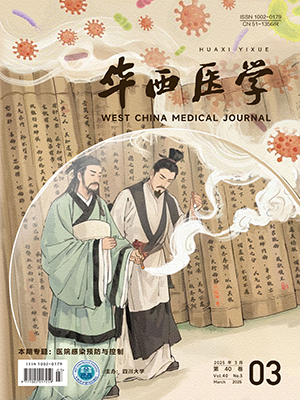Objective
To explore the feasibility and effect of infusion pump potassium supplementation in continuous renal replacement therapy (CRRT).
Methods
Patients who underwent CRRT were randomly divided into infusion pump group and traditional way group between March and May 2018. In infusion pump group, 10% potassium chloride was supplemented with infusion pump. In traditional way group, 10% potassium chloride was supplemented in the traditional way, which meant adding potassium in the replacement solution. The peripheral blood potassium level, the potassium well-controlled rate, the incidence of adverse events, the average frequency of replacement liquid bags change, the average pump stopping time, and the delivery dose and potassium supplement dose between the two groups were compared.
Results
A total of 60 patients were randomly divided into two groups, with 30 cases in each group. The infusion pump group was treated with an average of 6.90 mL/h potassium supplement dose by infusion pump, and in traditional way group, potassium was added to the replacement solution by an average of 9.29 mL/h; there were significant differences between the two groups (P<0.05). When compared with traditional way group, there was no significant differences (P>0.05) in the peripheral blood potassium level and the potassium well-controlled rate of the patients at 0, 2, 8, 12 and 24 hours after CRRT (P>0.05). As for the adverse events rate, average frequency of replacement liquid bags change, average pump stopping time, and potassium supplement dose, there were significant differences between the two groups (P<0.05).
Conclusions
The application of infusion pump to supply potassium in CRRT is feasible and safe, and is superior to the traditional potassium supplement method. It could be further applied in clinical practice.
Citation:
CHEN Zhiwen, TANG Xiaojuan, WANG Beibei, ZHANG Sheng, WEI Tiantian, DAI Mingjin. Comparison of potassium supplement with infusion pump and traditional potassium supplement in continuous renal replacement therapy. West China Medical Journal, 2018, 33(7): 856-859. doi: 10.7507/1002-0179.201807008
Copy
Copyright © the editorial department of West China Medical Journal of West China Medical Publisher. All rights reserved
| 1. |
付平. 连续性肾脏替代治疗. 北京: 人民卫生出版社, 2016: 3.
|
| 2. |
陈香美. 血液净化标准操作规程 2010 版. 北京: 人民军医出版社, 2010: 47, 68-69.
|
| 3. |
蔡吉, 赵慧华, 张育红, 等. 微量泵输注高浓度氯化钾临床应用的护理进展. 护理学杂志, 2012, 27(22): 93-96.
|
| 4. |
RENAL Replacement Therapy Study Investigators, Bellomo R, Cass A, et al. Intensity of continuous renal-replacement therapy in critically ill patients. N Engl J Med, 2009, 361(17): 1627-1638.
|
| 5. |
Kidney disease: improving global outcomes (KDIGO) acute kidney injury work group. KDIGO clinical practice guideline for acute kidney injury. Kidney Int Suppl, 2012, 2(1): 1-138.
|
| 6. |
黄家驷, 吴阶平. 外科学 (上册). 北京: 人民卫生出版社, 1982: 150-151.
|
| 7. |
郑惠鹏, 史伟. 微泵静脉注射氯化钾溶液抢救严重低钾血症 1 例. 广东医学, 2005, 26(1): 119.
|
| 8. |
王海龙, 张亚会, 唐莉杰. 高浓度氯化钾微量泵注射在重度低钾血症中的应用. 中国医药指南, 2011, 9(13): 122-123.
|
| 9. |
刘辉, 杨晓华, 王苏华. 微量泵高浓度泵钾在心脏瓣膜置换术后早期的应用. 西部医学, 2010, 22(12): 2348-2349.
|
| 10. |
陈雪芳. 10 例应用微量泵外周静脉高浓度补钾的临床观察与护理. 全科护理, 2009, 7(4): 895-896.
|
| 11. |
陆再英, 钟南山. 内科学. 7 版. 北京: 人民卫生出版社, 2008: 689-691.
|
| 12. |
Bundgaard H, Kjeldsen K. Potassium depletion increases potassium clearance capacity in skeletal muscles in vivo during acute repletion. Am J Physiol Cell Physiol, 2002, 283(4): C1163-C1170.
|
| 13. |
Uijtendaal EV, Zwart-van Rijkom JE, van Solinge WW, et al. Frequency of laboratory measurement and hyperkalaemia in hospitalised patients using serum potassium concentration increasing drugs. Eur J Clin Pharmacol, 2011, 67(9): 933-940.
|
| 14. |
王艳, 曹积慧. 锁骨下静脉微量泵高浓度补钾的疗效观察. 中国医药指南, 2016, 34(14): 152-153.
|
| 15. |
邓岩. 静脉注射高浓度氯化钾抢救严重低血钾一例. 中外医疗, 2010(32): 83.
|
| 16. |
张利娟, 黄金美, 费忠英. 微量泵注射高浓度氯化钾治疗严重低钾血症患者的护理进展. 当代护士: 下旬刊, 2014, 10(3): 7-9.
|
- 1. 付平. 连续性肾脏替代治疗. 北京: 人民卫生出版社, 2016: 3.
- 2. 陈香美. 血液净化标准操作规程 2010 版. 北京: 人民军医出版社, 2010: 47, 68-69.
- 3. 蔡吉, 赵慧华, 张育红, 等. 微量泵输注高浓度氯化钾临床应用的护理进展. 护理学杂志, 2012, 27(22): 93-96.
- 4. RENAL Replacement Therapy Study Investigators, Bellomo R, Cass A, et al. Intensity of continuous renal-replacement therapy in critically ill patients. N Engl J Med, 2009, 361(17): 1627-1638.
- 5. Kidney disease: improving global outcomes (KDIGO) acute kidney injury work group. KDIGO clinical practice guideline for acute kidney injury. Kidney Int Suppl, 2012, 2(1): 1-138.
- 6. 黄家驷, 吴阶平. 外科学 (上册). 北京: 人民卫生出版社, 1982: 150-151.
- 7. 郑惠鹏, 史伟. 微泵静脉注射氯化钾溶液抢救严重低钾血症 1 例. 广东医学, 2005, 26(1): 119.
- 8. 王海龙, 张亚会, 唐莉杰. 高浓度氯化钾微量泵注射在重度低钾血症中的应用. 中国医药指南, 2011, 9(13): 122-123.
- 9. 刘辉, 杨晓华, 王苏华. 微量泵高浓度泵钾在心脏瓣膜置换术后早期的应用. 西部医学, 2010, 22(12): 2348-2349.
- 10. 陈雪芳. 10 例应用微量泵外周静脉高浓度补钾的临床观察与护理. 全科护理, 2009, 7(4): 895-896.
- 11. 陆再英, 钟南山. 内科学. 7 版. 北京: 人民卫生出版社, 2008: 689-691.
- 12. Bundgaard H, Kjeldsen K. Potassium depletion increases potassium clearance capacity in skeletal muscles in vivo during acute repletion. Am J Physiol Cell Physiol, 2002, 283(4): C1163-C1170.
- 13. Uijtendaal EV, Zwart-van Rijkom JE, van Solinge WW, et al. Frequency of laboratory measurement and hyperkalaemia in hospitalised patients using serum potassium concentration increasing drugs. Eur J Clin Pharmacol, 2011, 67(9): 933-940.
- 14. 王艳, 曹积慧. 锁骨下静脉微量泵高浓度补钾的疗效观察. 中国医药指南, 2016, 34(14): 152-153.
- 15. 邓岩. 静脉注射高浓度氯化钾抢救严重低血钾一例. 中外医疗, 2010(32): 83.
- 16. 张利娟, 黄金美, 费忠英. 微量泵注射高浓度氯化钾治疗严重低钾血症患者的护理进展. 当代护士: 下旬刊, 2014, 10(3): 7-9.
Journal type citation(1)
| 1. | 刘欣,沈会,姜永珊,王政芃,李佳睿,李梦洁,代露,解建国,朱炜楷. 基于CiteSpace可视化分析国内脑梗死与炎症的研究热点与趋势. 中风与神经疾病杂志. 2024(07): 619-625 .  Baidu Scholar Baidu Scholar | |
Other types of references(0)





 Baidu Scholar
Baidu Scholar